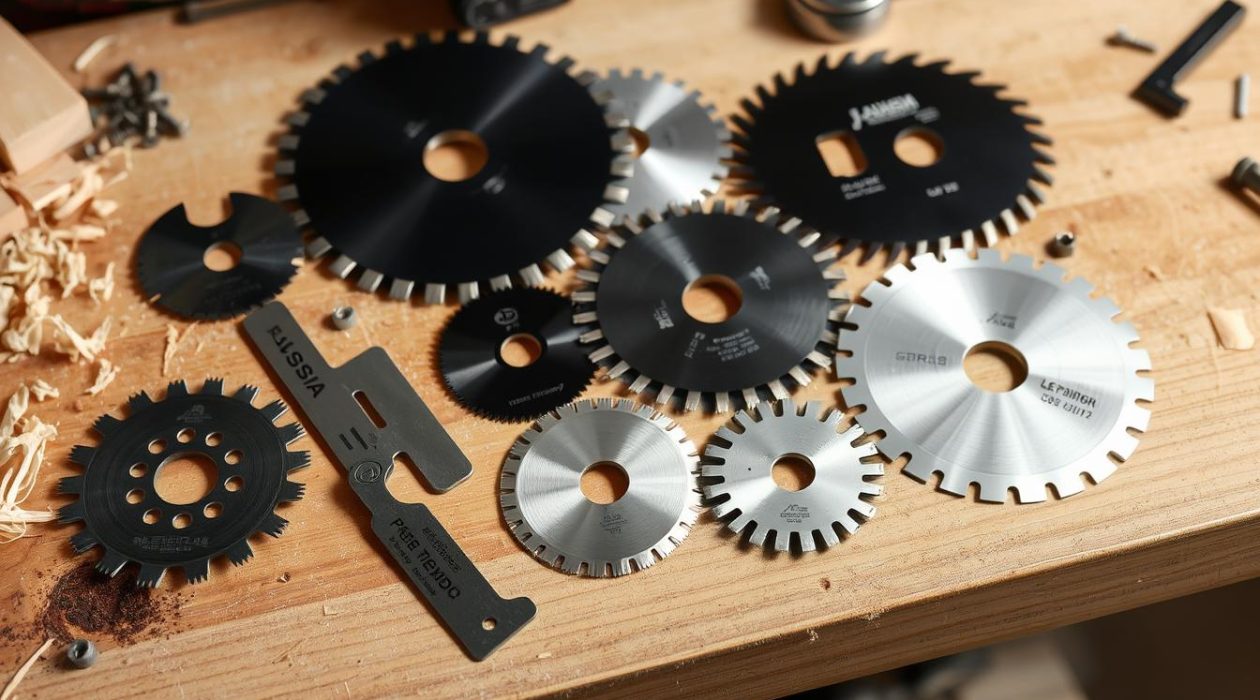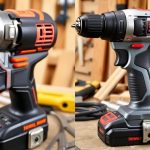Oscillating tool blades are a game-changer for DIY enthusiasts, offering unmatched precision and flexibility. They are essential for various tasks, designed to cut, scrape, and sand. This makes them a must-have for both serious DIY enthusiasts and professionals. Their versatility in handling a wide range of materials makes them ideal for woodworking, metal fabrication, and more.
Whether you’re an experienced DIY expert or just starting, oscillating tool blades are crucial. They offer versatility for cutting, scraping, sanding, and polishing. By using these blades, you can elevate your DIY projects, achieving professional-grade results with ease.
Introduction to Oscillating Tool Blades
Oscillating tool blades have become increasingly popular due to their versatility and precision. They are designed to work with various materials, including wood, metal, and drywall. This makes them a must-have for any DIY enthusiast.
Key Takeaways
- Oscillating tool blades are a versatile DIY cutting tool
- They can be used for cutting, scraping, and sanding
- Perfect for woodworking, metal fabrication, and other projects
- Indispensable for any serious DIY enthusiast or professional
- Provide a level of precision and flexibility that makes them a must-have
- Oscillating tool blades are designed to work with a variety of materials
Understanding Oscillating Tool Blades: A DIY Essential
Oscillating tools are a versatile and essential component of any DIY toolkit. To get the most out of your oscillating tool, it’s crucial to understand the different types of blades available. A tool blade guide can be incredibly helpful in this process. It provides valuable information on the various types of blades and their uses.
When it comes to oscillating tools, there are several types of blades to choose from. Each has its own unique characteristics and uses. Some common types include:
- Saw blades, used for cutting through wood and other materials
- Scraping blades, used for removing old adhesive and other substances
- Sanding blades, used for smoothing out surfaces
It’s also important to consider safety precautions when using oscillating tools. This includes wearing protective gear, such as gloves and safety glasses. Ensuring that the tool is properly maintained and stored is also crucial. By following these guidelines and using the right blade for the job, you can unlock the full potential of your oscillating tool. This will help you achieve professional-looking results.
With the right oscillating tools and a little practice, you can tackle a wide range of DIY projects with confidence. Whether you’re a seasoned pro or just starting out, understanding the basics of oscillating tool blades is essential. It ensures your success and safety.
| Blade Type | Use | Safety Precaution |
|---|---|---|
| Saw Blade | Cutting through wood and other materials | Wear protective gear, such as gloves and safety glasses |
| Scraping Blade | Removing old adhesive and other substances | Ensure proper ventilation and wear a mask |
| Sanding Blade | Smoothing out surfaces | Wear protective gear, such as gloves and safety glasses |
Getting Started with Basic Cutting Applications
When diving into DIY cutting tools, oscillating tool blades stand out as a must-have. Understanding the basics of using your oscillating tool is key. Start by learning which materials you can cut, like wood, metal, drywall, and plaster.
Choosing the right blade is crucial for success. Consider these factors:
- Material compatibility: Make sure the blade is right for the material you’re cutting.
- Blade speed: Adjust the speed based on the material and the cut needed.
- Pressure: Use the correct amount of pressure to avoid damage to the material or blade.
Mastering these skills will help you move on to more complex DIY projects. Always follow safety guidelines and use proper techniques for the best results.
With time and practice, you’ll get better at using oscillating tool blades for different cuts. This will make your DIY projects more efficient and enjoyable.
| Material | Blade Type | Speed | Pressure |
|---|---|---|---|
| Wood | Wood blade | Medium | Light |
| Metal | Metal blade | High | Medium |
| Drywall | Drywall blade | Low | Light |
Woodworking Projects Using Oscillating Tool Blades
Oscillating tools have become crucial in woodworking, offering unmatched precision and control. They are ideal for both seasoned woodworkers and beginners. With these tools, you can achieve professional-grade results in your projects.
These tools are versatile, suitable for various tasks. From detailed trim work to intricate wood carvings, oscillating tool blades excel. Here are some woodworking projects that benefit from their use:
- Creating custom furniture pieces, such as cabinets and tables
- Building decorative trim and molding for walls and ceilings
- Carving intricate designs and patterns into wood
Detailed Trim Work
Oscillating tool blades excel in detailed trim work. Their precision allows for intricate cuts and designs. This is a feat that other DIY cutting tools often struggle to achieve.
Custom Joinery Solutions
For custom joinery, oscillating tool blades are invaluable. They enable the creation of strong, durable joints. This is crucial for projects that require longevity and stability.
| Project | Oscillating Tool Blade Used |
|---|---|
| Custom furniture | Woodcutting blade |
| Decorative trim | Metal-cutting blade |
| Wood carving | Specialty blade |
Metal Fabrication and Modification Tasks
Oscillating tool blades are essential for metal fabrication and modification. The right tool blade guide ensures precise cuts and shapes in various metals. These blades are perfect for cutting pipes, grinding bolts, or shaping sheets efficiently.
Common tasks include:
- Cutting through metal pipes and tubes
- Grinding down rough edges and burrs
- Shaping and molding metal sheets and plates
Using oscillating tool blades saves time and effort in metalwork. They are built to withstand metalworking challenges, making them a dependable choice. With the correct tool blade guide, you can enhance your oscillating tool’s performance and improve your metalworking skills.
Always adhere to safety guidelines and use the right tool blade guide for your project. With proper techniques and tools, you can achieve professional-grade results in metal fabrication and modification.
Home Renovation Applications
Oscillating tools are a must-have for any DIY enthusiast, perfect for home renovation tasks. They offer versatility and precision, making them ideal for various projects. Whether you’re dealing with drywall, plaster, flooring, or repairs, these tools are crucial.
Choosing the right blade is key when using oscillating tools. Each blade is tailored for specific tasks like cutting, scraping, or sanding. The correct blade ensures a smooth and efficient renovation process.
- Drywall and plaster work: Ideal for cutting and scraping, making them vital for any renovation.
- Flooring installation and repair: With the right blade, they can cut and remove old flooring and install new ones.
- Window and door frame modifications: Perfect for cutting and shaping frames, adding versatility to any project.
Using DIY cutting tools and oscillating tools in your renovation saves time and effort. They help achieve professional-grade results. Their versatility and precision make them essential for any DIY enthusiast.
| Application | Tool | Blade |
|---|---|---|
| Drywall and plaster work | Oscillating tool | Plaster blade |
| Flooring installation and repair | Oscillating tool | Flooring blade |
| Window and door frame modifications | Oscillating tool | Wood blade |
Unconventional Uses in Garden and Outdoor Projects
Oscillating tool blades are not confined to indoor DIY tasks. They also excel in garden and outdoor projects, proving to be a versatile tool for homeowners. With the right tool blade guide, you can unlock your oscillating tool’s full potential. This opens up a wide range of tasks for you to tackle.
Some unconventional uses of oscillating tool blades in garden and outdoor projects include:
- Pruning and trimming plants and trees
- Crafting decorative elements, such as wooden planters and garden signs
- Removing old caulk and sealants from outdoor surfaces
- Scraping away rust and corrosion from metal furniture and decorations
Utilizing oscillating tool blades in your garden and outdoor projects can add a personal touch. It makes your outdoor space more beautiful and functional. Whether you’re an experienced DIY enthusiast or a beginner, these blades are a valuable addition to your toolkit.
A tool blade guide helps you choose the right oscillating tool blades for your needs. This ensures you get the most out of your tool. So, why not get creative and use oscillating tool blades in your next garden or outdoor project?
| Project | Tool Blade Type | Benefits |
|---|---|---|
| Pruning and trimming | High-carbon steel blade | Efficient cutting, long-lasting |
| Crafting decorative elements | Woodworking blade | Precise cuts, smooth finish |
| Removing old caulk and sealants | Scraping blade | Easy removal, no damage to surfaces |
Rescue and Repair Operations
In emergency situations, the right tools can be a game-changer. DIY cutting tools, like oscillating tools, are crucial in rescue and repair efforts. They enable the precise removal of damaged materials, making emergency repairs possible and supporting salvage operations.
Having the correct equipment is vital for a safe and effective rescue operation. Oscillating tools stand out in these scenarios, offering the precision and control needed to remove damaged materials safely.
The benefits of using oscillating tools in rescue and repair efforts are numerous. They include:
- Precise removal of damaged materials
- Facilitation of emergency repairs
- Aid in salvage operations
By employing DIY cutting tools, individuals can effectively tackle emergency situations. They can perform rescue and repair operations with confidence. It’s crucial to have the right tools and knowledge for a successful outcome in these critical moments.
Maximizing Blade Life and Performance
To maximize the life and performance of your oscillating tool blades, proper care and maintenance are crucial. This includes understanding the best storage methods to prevent damage and corrosion. It also involves how to clean and maintain the blades for optimal performance.
Proper Storage Methods
Storing your oscillating tool blades correctly can significantly extend their lifespan. Keep them in a dry place, away from direct sunlight. Consider using a tool blade guide to organize and protect your blades.
Cleaning and Maintenance Tips
Regular cleaning and maintenance are essential for maintaining the performance of your oscillating tool blades. Use a soft cloth to wipe down the blades after each use. Avoid harsh chemicals that can damage the metal. For tougher cleaning tasks, a mild soap solution can be used.
Here are some additional tips to keep in mind:
- Always dry your blades thoroughly after cleaning to prevent rust.
- Apply a small amount of oil to the blades to keep them lubricated and protected.
- Use a tool blade guide to help you clean hard-to-reach areas.
By following these simple tips and using the right oscillating tool blades for your projects, you can ensure your tools remain in good condition. They will continue to perform well over time.
| Tip | Description |
|---|---|
| Regular Cleaning | Use a soft cloth to wipe down the blades after each use. |
| Proper Storage | Keep blades in a dry place, away from direct sunlight. |
| Lubrication | Apply a small amount of oil to the blades to keep them lubricated and protected. |
Advanced Techniques for Precision Work
For those aiming to refine their skills, learning advanced techniques with oscillating tools is crucial. These methods allow users to produce professional-quality results in various tasks. This includes making precise cuts and fine sanding. It’s vital to grasp the capabilities and limits of your DIY cutting tools when using them.
To achieve precision, consider the following tips:
- Choose the right blade for your project, taking into account the material and desired outcome.
- Adjust the speed and pressure according to the task, ensuring a smooth and controlled operation.
- Use specialized attachments, such as sanding pads or cutting guides, to enhance precision and accuracy.
By mastering these advanced techniques and using the right oscillating tools and DIY cutting tools, you can unlock new possibilities for your projects. This will help you achieve exceptional results.
Selecting the Right Blade for Your Project
Choosing the right oscillating tool blades is crucial, depending on the material you’re working with. A tool blade guide can be very helpful in making this decision. For instance, when cutting wood, a blade with a high tooth count is ideal. This ensures a smooth cut.
For metal, a blade with a low tooth count is better. It’s designed for efficient cuts through metal. Knowing the different types of blades and their uses is key. Here are some important considerations:
Material Compatibility Guide
- Wood: Look for blades with a high tooth count and a gentle curve for smooth cuts.
- Metal: Choose blades with a low tooth count and a aggressive curve for efficient cuts.
- Plastic: Opt for blades with a medium tooth count and a straight curve for clean cuts.
Speed and Pressure Recommendations
Using the right speed and pressure is essential for optimal performance. For soft materials, use high speed and low pressure. For hard materials, low speed and high pressure are recommended. Following these guidelines helps achieve professional results and extends blade life.
Choosing the right oscillating tool blades is critical for success. Consider the material and follow the guidelines in this guide. This ensures you select the right blade for your project, leading to efficient and effective work.
| Material | Blade Type | Speed | Pressure |
|---|---|---|---|
| Wood | High tooth count | High | Low |
| Metal | Low tooth count | Low | High |
| Plastic | Medium tooth count | Medium | Medium |
Conclusion: Unleashing Your Oscillating Tool’s Full Potential
As we wrap up our journey into oscillating tool blades, it’s evident they are crucial for any DIY enthusiast. These tools excel in various tasks, from woodworking to metalwork. By grasping the different blade types, their characteristics, and upkeep, you can maximize this tool’s capabilities. This empowers you to handle a broad spectrum of DIY projects confidently.
Success hinges on choosing the correct blade for the task and using it correctly. Whether it’s intricate trim work, custom joinery, or urgent repairs, the right blade is pivotal. With dedication and a drive for improvement, you’ll turn your DIY dreams into reality with finesse and speed.
Now, as you start your next endeavor, harness the might of oscillating tool blades and let your imagination run wild. The scope of possibilities is vast, and the joy of a job well executed is its own reward. Enjoy your DIY journey!


